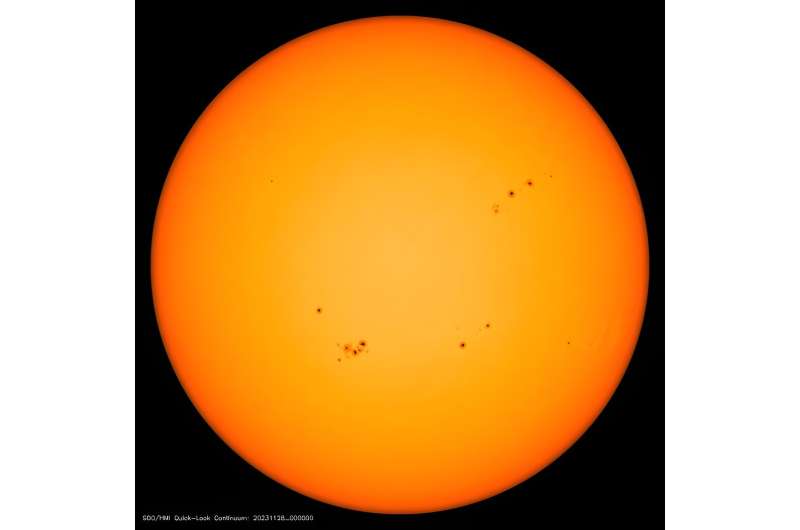This article has been reviewed according to Science X's editorial process and policies. Editors have highlighted the following attributes while ensuring the content's credibility:
fact-checked
peer-reviewed publication
trusted source
proofread
Solar activity likely to peak next year, new study suggests

Researchers at the Center of Excellence in Space Sciences India at IISER Kolkata have discovered a new relationship between the sun's magnetic field and its sunspot cycle, that can help predict when the peak in solar activity will occur. Their work indicates that the maximum intensity of solar cycle 25, the ongoing sunspot cycle, is imminent and likely to occur within a year. The new research appears in Monthly Notices of the Royal Astronomical Society: Letters.
Our star, the sun, is made up of hot ionized gas known as plasma. Huge plasma flows and convection conspire together to form magnetic fields inside the sun which manifest on the surface as dark spots. These sunspots are comparable to the size of Earth and are seats of intense magnetism, about 10,000 times stronger than Earth's magnetic field.
Sometimes the sunspot magnetic fields are disrupted in violent events which result in the birth of solar magnetic storms such as flares or coronal mass ejections. These storms release high-energy radiation and hurl vast amounts of magnetized plasma into outer space. The most intense of these storms can cause serious damage to orbiting satellites, electric power grids and telecommunications when directed toward Earth.
Centuries of observations starting from the early 1600s show that the number of sunspots observed on the sun varies periodically. Approximately every 11 years the number of spots and the intensity of solar activity reach a peak when the most violent perturbations in planetary space environments—or space weather—are expected. However, predicting when this peak is going to occur has remained challenging.
The solar cycle is produced by a dynamo mechanism driven by energy from plasma flows inside the sun. This dynamo mechanism is understood to involve two primary components of the sun's magnetic field, one which manifests in the cycle of sunspots and another which manifests in the recycling of the large-scale dipole field of the sun; the latter is much like Earth's magnetic field—stretching from one pole of the sun to another. With the cycle of sunspots, the sun's dipole field is also observed to wax and wane in strength, the north and south magnetic poles swap places, also every 11 years.
In 1935, Swiss astronomer Max Waldmeier discovered that the faster the rate of rise of a sunspot cycle the stronger its strength, so stronger cycles take less time to rise to their peak intensity. This relationship has often been utilized to forecast the strength of a sunspot cycle based on observations of its early rising phase.
This discovery complements the Waldmeier effect, connecting the two primary magnetic field components of the sun and supporting the theory that the evolution of sunspots are integral to the functioning of the solar dynamo process rather than being a mere symptom of it.
These new observations of the rate of decrease of the sun's dipole magnetic field can be usefully combined with sunspot observations to predict when the ongoing cycle would peak. The analysis suggests that the maximum of solar cycle 25 is most likely to occur in early 2024, with an uncertainty in the estimate that ranges to September 2024.
With this latest discovery, a new window opens up for forecasting the timing of the peak of solar cycles—when the most intense activity and most frequent space weather disturbances are expected.
More information: Priyansh Jaswal et al, Discovery of a relation between the decay rate of the Sun's magnetic dipole and the growth rate of the following sunspot cycle: a new precursor for solar cycle prediction, Monthly Notices of the Royal Astronomical Society: Letters (2023). DOI: 10.1093/mnrasl/slad122
Journal information: Monthly Notices of the Royal Astronomical Society Letters
Provided by Royal Astronomical Society




















